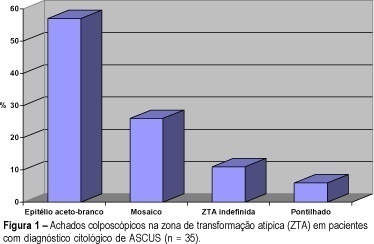Summary
Revista Brasileira de Ginecologia e Obstetrícia. 1999;21(9):509-515
DOI 10.1590/S0100-72031999000900003
Purpose: to evaluate the relationship between uterine contractions and premature delivery. Methods: between February 1996 and July 1998, 73 high risk pregnant women for preterm delivery, between the 24th and 34th weeks of gestation, were submitted to uterine contraction monitoring with tokodynamometers for 1 hour twice a week. The positive test was the presence of 4 contractions/h before the 30th week of gestation, and after this time, 6 contractions/h. Result: of 73 women, 17 patients (23.28%) were excluded from the final analysis because they presented obstetric problems or unfavorable development for the final result. The rate of preterm delivery was 21.23% (13/56). The mean frequency of uterine contractions was greater in women with preterm delivery than in those with term delivery. The test presented sensitivity of 69.23%, specificity of 86.04%, positive predictive value of 60% and negative predictive value of 90.24%. Conclusion: negative tests are associated with a low risk of preterm birth. When the test is positive, association with other premature delivery markers is necessary to improve our ability to efficiently identify patients at risk for preterm delivery.
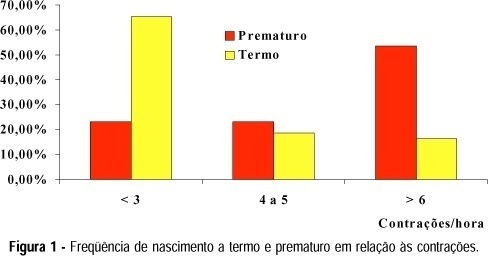
Summary
Revista Brasileira de Ginecologia e Obstetrícia. 1999;21(9):499-504
DOI 10.1590/S0100-72031999000900002
Purpose: to evaluate the ultrasound characteristics of normal pregnancies, according to the placental maturity, local of insertion and thickness, fetal presentation and position during the second half of pregnancy. Methods: a descriptive study was perfomed, including at least 120 measures in each gestational age, in 2,868 normal pregnant women from Campinas, Brazil, studied through routine obstetric ultrasound examinations, with fetal biometry and placental evaluation, applying Grannum, Berkowitz, Hobbins (1979) criteria for placental maturity. Placental thickness was measured at the cord insertion site. Results: grade 0 placentas were more frequent up to 31 weeks and grade I after 32 weeks. Grade II did not appear until 32 weeks and grade III was more frequent after 36 weeks. The placental thickness significantly increased with gestational age and the most frequent placental locations were anterior and posterior. The cephalic presentation was the most frequent all gestational ages, with only 1% of breech presentation at term. The most frequent fetal position was fetal spine left side, followed by right side. Conclusions: the studied factors showed a similar distribution to that expected for normal populations and could be used as a standard for the Brazilian population.
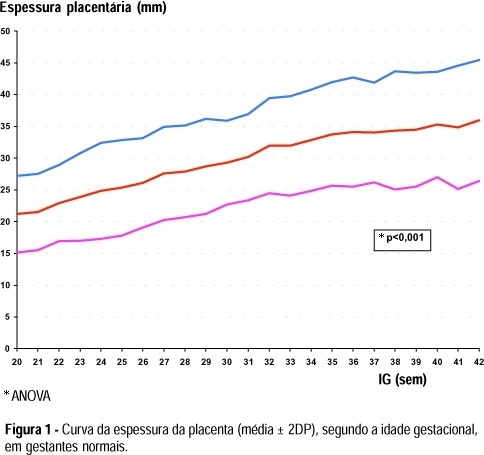
Summary
Revista Brasileira de Ginecologia e Obstetrícia. 1999;21(10):579-584
DOI 10.1590/S0100-72031999001000003
Purpose: to evaluate the accuracy of maternal perception of fetal movements (MPFM) in diabetic pregnant women, using Apgar score at the 1st and 5th min of life, intrapartum fetal distress and neonatal hypoxia as parameters. Methods: two hundred and nine diabetic women evaluated at the High Risk Prenatal Care Clinic of the Women's Hospital (CAISM) were analyzed retrospectively between June 1988 and May 1996. All patients had MPFM records within three days before delivery, fetal heart rate recordings during labor, gestational age greater than 30 weeks and a complete neonatal evaluation. MPFM was classified as normal if seven movements were recorded in 60 min. Results: the sensitivity of the test was 23 and 29% for Apgar score <7 at the 5th min and intrapartum fetal distress, respectively, and close to 50% for neonatal hypoxia (45.5%). Specificity was near 95% for the three standards, and the negative predictive value (NPV) was 80% for fetal distress, increasing to 97 and 98% for Apgar >7 at 5 min and neonatal hypoxia. Conclusions: MPFM is a useful test to identify diabetic women needing fetal evaluation with more complex techniques, given the high NPV, that indicates the capacity to separate the cases where the fetus is in good condition.
Summary
Revista Brasileira de Ginecologia e Obstetrícia. 1999;21(10):569-576
DOI 10.1590/S0100-72031999001000002
Purpose: to estimate growth curves and tables of average biparietal diameter and average head circumference of twin gestations and to compare them with published growth curves for singletons and twins. Methods: growth curves and tables of average biparietal diameter and average head circumference were obtained from sonographic examinations of 34 patients with twin gestations without maternal and fetal complications. Sonographic examinations were performed each 2 or 3 weeks by a single observer. The parameters were compared with existing growth curves for singletons and twins. Results: curves and tables of biparietal diameter and head circumference in relation to gestational age were obtained. The study revealed difference in growth pattern mainly regarding the 3rd trimester in relation to singletons (Hadlock et al.15). The difference between the average values were 6 mm (biparietal diameter) and 2.0 cm (head circumference) at the 39th week of gestation. Also, some differences were observed relative to the twin studies. Conclusion: this study revealed that growth curves for average biparietal diameter and average head circumference of singletons are not appropriate to determine gestational age in twin gestations of the studiced population principally at the 3rd trimester
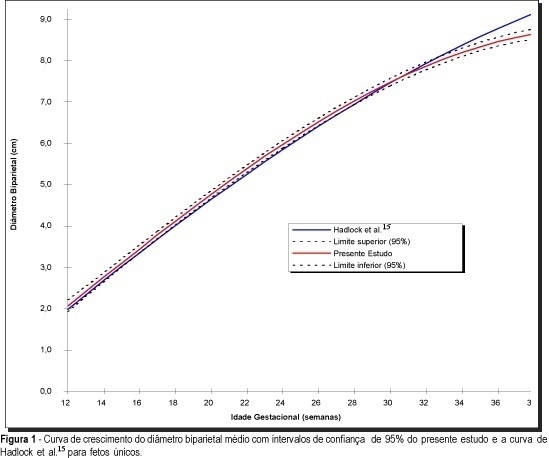
Summary
Revista Brasileira de Ginecologia e Obstetrícia. 1999;21(10):597-602
DOI 10.1590/S0100-72031999001000006
Purpose: evaluation of the effect of elcometrine on ovarian endometriomata. Method: subdermal implants containing 50 mg elcometrine were inserted in 51 women with ovarian endometriomata, the volumes of which were recorded by vaginal sonography before and after each three-month interval of treatment. A new implant was inserted every 6 months according to the need for continuing treatment. Results: at admission, 74% of patients presented with dysmenorrhea, 57% chronic pelvic pain and 31% dyspareunia. Pain was rated as severe or incapacitating by 82% of the subjects. A total of 924 months of observation was recorded during the four years of study. Relief of pain was observed during the first month of treatment and severe or incapacitating pain was no longer reported by any subject by the end of the first trimester. Volume of endometriomata was reduced in 86% of the patients. In 45%, ovarian volume was restored to normal. In 41% the volume reduction was incomplete and in 14% there was no volume reduction. Seventy-seven percent presented amenorrhea during treatment. The most common adverse events were decreased libido (21%) and feeling of heaviness in lower limbs (14%). One year after discontinuation of treatment, 33% of the patients were symptomless, while 28% presented recurrence of the endometriomata before 3 months post-discontinuation. Thirty-nine percent of the patients preferred to continue using the method in order to maintain amenorrhea. Conclusion: elcometrine is effective in reducing ovarian endometriomata, without some of the side effects of other treatments.
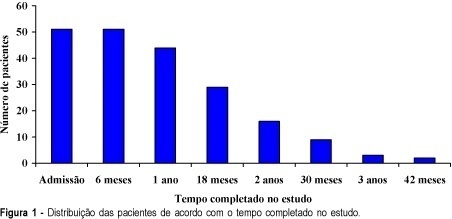
Summary
Revista Brasileira de Ginecologia e Obstetrícia. 2000;22(3):147-152
DOI 10.1590/S0100-72032000000300005
Purpose: to assess the commonest vulvovaginal complaints and vaginal discharge etiology in the Child and Teenager Gynecologic Outpatient Clinic of the University Hospital of Brasília (AGIP/HUB). Methods: we evaluated retrospectively 210 charts of patients, younger than 19 years old, who attended AGIP/HUB with vulvovaginal complaints. Results: the average age of the 210 patients was 12 ± 2.3 years, and the vaginal discharge and vulvar pruritus were the commonest complaints. Unspecific inflammatory conditions were observed in 147 (70%) of these patients and their treatment consisted of appropriate clothing, daily activities and hygienic orientation. Antibiotic treatment was necessary in 63 patients, where specific etiologic agents were found. Gardnerella, Trichomonas, HPV and syphilis were observed only in sexually active patients. They had had their first sexual intercourse when they were 14.1 ± 1.6 years old. Twenty patients also presented vulvar complaints that were easy to handle. Conclusion: Hygiene, clothing and adequate orientation for these patients and their families are fundamental to treat vulvovaginitis, almost always avoiding the use of antibiotics.
Summary
Revista Brasileira de Ginecologia e Obstetrícia. 2000;22(3):141-146
DOI 10.1590/S0100-72032000000300004
Purpose: urinary tract involvement by endometriosis is uncommon and the bladder is the most common site. We observed that clinical misdiagnosis of bladder cancer frequently is made. Because the disease is generally described in case reports there is not a consensual management. We present and discuss our experience of diagnostic and therapeutic issues. Methods: retrospective analysis of urinary endometriosis slides of the Department of Pathology files was made. Medical charts and follow-up were reviewed in detail and interviews were performed during or after treatment. Results: we describe four cases with cyclic disuria, abdominal mass, pelvic pain and imaging diagnosis of bladder tumor. Pathological specimens were obtained by endoscopic resection (3 cases) and laparoscopic biopsy (1 case). Therapeutic options were exclusive medical treatment or surgical removal with transurethral resection or partial cystectomy supplemented with adjuvant medication. Conclusions: we review the clinical and therapeutic aspects of urinary tract endometriosis stressing that this is an important differential diagnosis of bladder cancer in reproductive women.
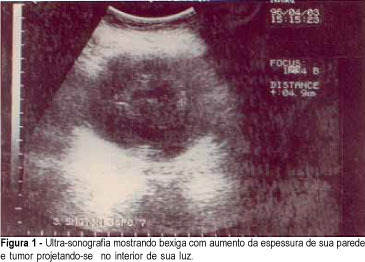
Summary
Revista Brasileira de Ginecologia e Obstetrícia. 2000;22(3):135-139
DOI 10.1590/S0100-72032000000300003
Purpose: to assess clinical, colposcopic profile and follow-up of patients with a cytological report of atypical squamous cells of undetermined significance (ASCUS). Methods: a total of 208 cases of ASCUS diagnosed between 1996 e 1998 were analyzed retrospectively regarding age, symptoms, colposcopy and follow-up. Results: the ASCUS:SIL (squamous intraepithelial lesion) ratio reported was 1:1.2, showing an adequate quality control. Most of the patients were between 15 and 35 years old (72.6 %). The majority referred no symptoms (36.5 %). The colposcopy showed (n = 58) the atypical zone of transformation in 60% of the cases. The subclassification into ASCUS favoring a dysplasia (ASCUS--D), reactive process (ASCUS-R) and unqualified (ASCUS-U) showed that 65% of cases belonged to the first category (ASCUS-D). In the follow-up of 86 patients for 3 to 6 months (average of 4.5 months), 12.5% had a subsequent SIL. Conclusion: the findings of this study indicate that ASCUS occurrence in young women with common symptoms, is frequent and there is the possibility of diagnosing by colposcopy. The follow-up is very important to define the concurrent or subsequent development of a squamous intraepithelial lesion.
